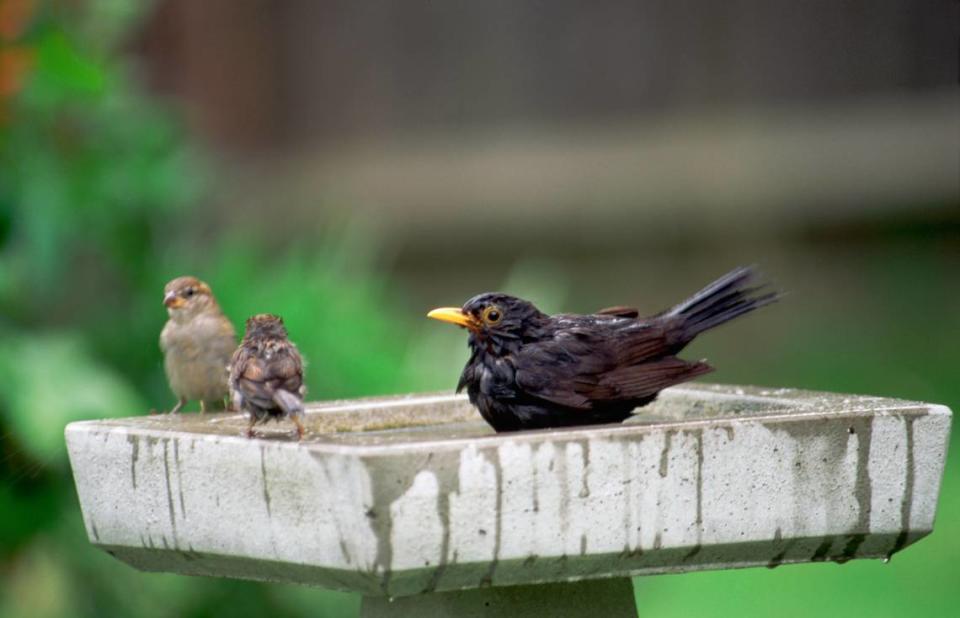Now’s the time to bait for slugs — and make sure bird baths are full during dry, hot days
The third week of August is when you may be getting tired of your garden. Late summer is when gardeners become tired of watering, tired of deadheading and tired of harvesting zucchini. Hang in there for the August refresh as we still have months of outdoor living ahead.
The No. 1 tip for Western Washington gardeners is to bait for slugs this month. Using pet-safe slug baits such as Worry Free or Sluggo in the letter “A” months of April and August will make the biggest dent in your slug population.
In August the slugs will gravitate to cool and shaded areas around the house and fence foundations, in groundcovers and anyplace that has damp soil or leaking water. This is your chance to apply the slug bait to these areas and disperse with a generation of slugs and snails by stopping this year’s slugs before they mate.
Tip: You will not see dead slugs when you use the pet safe slug baits as the active ingredient (iron) kills them after they crawl back home and hide under the rock they came from. To keep birds and mice from eating the bait, hide it under foliage or an overturned clay pot with one side propped up. (Pet-safe slug baits will not harm the birds. The extra iron just gives their feathers a healthy shine. )
Q. Love your garden tips in the newspaper and I also follow you on Instagram. My question is why you don’t remind people to clean and fill their birdbaths during times of heat and drought? Birds need water in the summer. Thanks you.
A. OK, I agree. Everyone clean and fill your bird baths during times of drought. Shallow bird baths are best both for birds and pollinating insects. You can add flat stones to a deep bird bath to make it easier for bees and butterflies to drink.
Q. When is a good time to take a cutting from a hydrangea? I saw a video of your hydrangea room and you mentioned you started many of your hydrangeas from cuttings. — G.P., Buckley
A. The month of August is a fine time to make new shrubs from the tip cuttings of branches. Hydrangeas, camellias, daphne, rhododendrons and many other shrubs can be propagated by removing a pencil long section of branch, pulling off the foliage on the lower half of the cutting and poking the cut end into moist soil.
Hydrangeas root so easily you won’t need rooting hormone powder or special growing medium. Just keep the cutting moist and out of direct sun. The node is the point on the stem where leaves emerge and this where the future roots will sprout so make sure the node is in the soil.
A raised bed or container full of potting soil is a good place to insert your stem tip cuttings. Take four or five cuttings and expect one to survive. Protect the cutting during the winter by keeping it close to the house, and in spring you will have a new plant. You can expect blooms in another year or two.
Or you can visit a local nursery this month and buy a full-grown hydrangea plant on sale as the growing season winds down and shrubs and trees are sold at a discount.
Q. I have started a compost pile. It is about 3 feet tall and 4 feet wide. Do I need to water this pile and if so how often must I water it? Keep in mind I will need to carry water to the pile as it is hidden behind a fence and my hose will not reach. — R.W., Email
A. The easy answer is no. If you never water your uncovered compost, the rains will still return in late September to activate the dry pile and then it can rot all winter. This passive composting method takes longer but still works to turn green material (grass clippings, faded blooms and weeds) and brown material (soil clinging to weeds, dead leaves and dead plants) into a chunky compost you can use in about a year to smother weeds and add organic matter to your soil.
Should you want compost sooner, then you will need to keep the pile moist. Water just enough to keep the pile as wet as a sponge that has been wrung out. So barely moist, but not wet. Chopping the contents up into smaller pieces and turning the pile to add air are other ways to speed decomposition. Or just pile up your garden garbage and let nature and rainfall rot it into soil.
See Marianne
Marianne Binetti will be at the Washington State Garlic Festival at the Southwest Washington Fairgrounds in Centralia on Aug. 25. She will speak at 11 a.m. on “Contain Yourself: Dos and Don’ts of Container Gardening and how to grow more food and more flowers in pots.”
Marianne Binetti has a degree in horticulture from Washington State University and is the author of several books. Reach her at binettigarden.com.
Lilies and phlox and dahlias, oh my! Here’s how to tackle the woes of these beauties
Tips for watering your garden efficiently during Western Washington’s drought season



